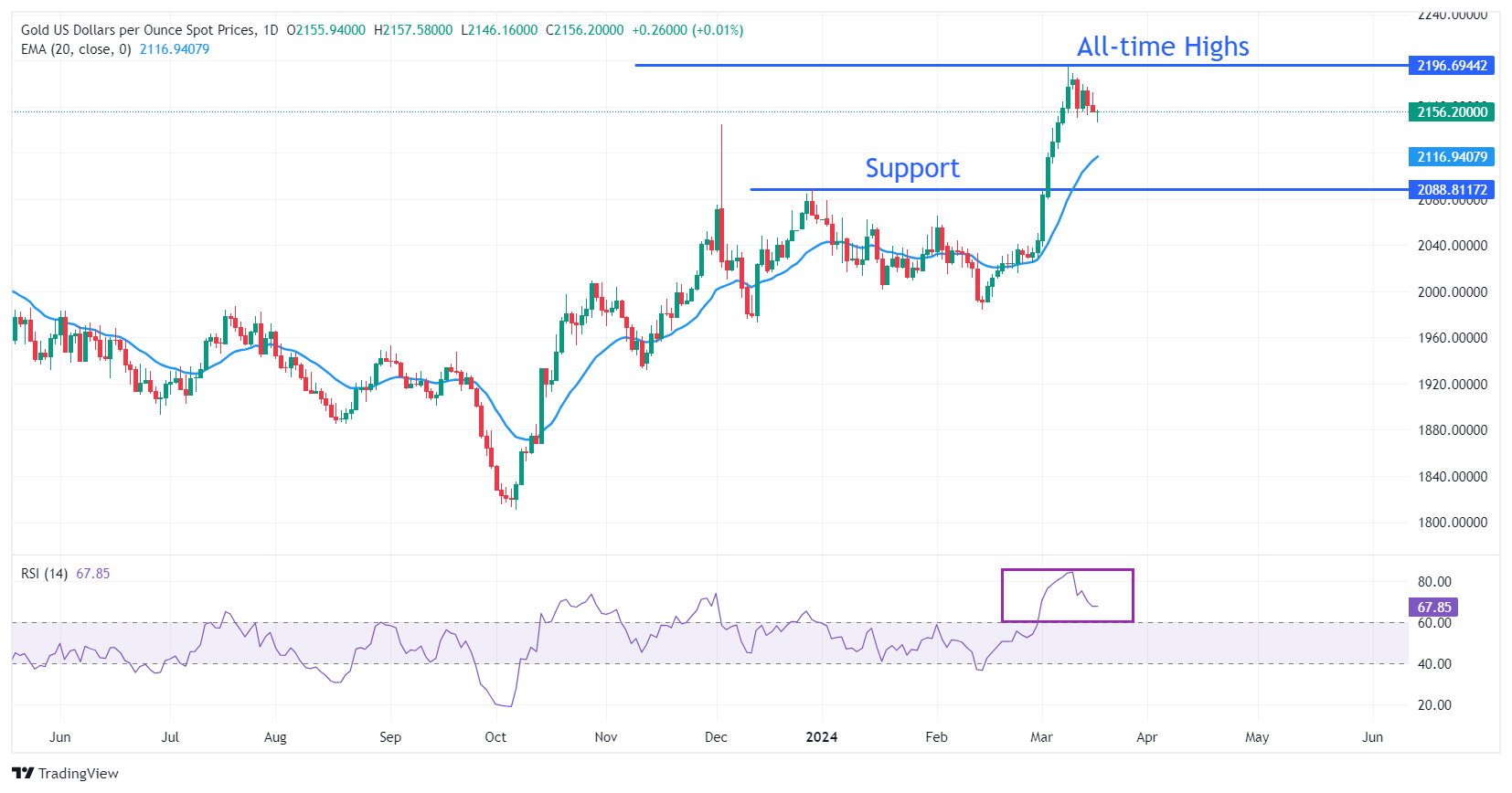- Gold price rises as the US Dollar turns subdued due to upbeat China data, which improves risk appetite.
- US yields remain firm due to diminished Fed rate cut expectations for June.
- This week, the Fed’s decision and guidance on interest rates will be keenly watched.
Gold price (XAU/USD) edges higher in Monday’s early New York session as the US Dollar faces pressure. The US Dollar Index (DXY) trades slightly lower at 103.40 due to improved risk appetite. The appeal for risk-sensitive assets strengthened due to the strong recovery in Chinese Retail Sales and Industrial Production data for February, which signals an improvement in China’s domestic demand.
Fading expectations for the Federal Reserve (Fed) to reduce interest rates in the June policy meeting have strengthened yields on interest-bearing assets. 10-year US Treasury yields have extended their upside to 4.33%, up by 0.45%. Higher US bond yields tend to increase the opportunity cost of holding an investment in non-yielding assets such as Gold.
This week, the Gold price will be guided by the Fed’s interest rate decision, which will be announced on Wednesday. The Fed is widely anticipated to keep interest rates unchanged in the range of 5.25%-5.50%. Therefore, the major focus will be on the interest rate guidance, which will be provided through the release of the so-called dot plot, a chart updated quarterly that shows interest rate projections from Fed officials for various timeframes.
Daily digest market movers: Gold price rises as US Dollar drops, US yields extend upside
- Gold price climbs back above $2,160 as the US Dollar comes under pressure. Investors await key interest rate meetings by various central banks this week. The near-term for the Gold price will be guided by the Federal Reserve’s monetary policy decision.
- The CME FedWatch tool shows that a steady decision for the March meeting is certain. Market participants will keenly focus on the dot plot, which indicates all policymakers’ expectations for interest rates over time and the latest economic projections. Investors will look for cues about when the Fed could start cutting interest rates.
- December’s dot plot showed policymakers don’t see the need to increase interest rates further and see three rate cuts this year. The Consumer Price Index (CPI) and associated inflation indicators for the first two months of 2024 have not been supportive of three rate cuts, as Fed policymakers want price pressures to decline for months to become confident that inflation will return to the 2% target. This could result in fewer rate-cut projections from Fed policymakers.
- Meanwhile, market expectations lean towards the June policy meeting when the Fed will start reducing key borrowing rates. However, the chances for the rate cut in June have come down significantly, as the consumer and producer price indices were surprisingly stubborn in February. The CME FedWatch tool shows that the chance for a rate cut stands at 57%, down from the 72% recorded before the release of the inflation data.
- Later this week, investors will focus on the preliminary S&P Global Manufacturing PMI for March. The Manufacturing PMI is anticipated to fall to 51.7 from 52.2 in February.
Technical Analysis: Gold price aims to sustain above $2,160
Gold’s price recovers sharply after hitting a fresh weekly low at around $2,145. As the divergence between the two wanes, the precious metal could continue its downside towards the 20-day Exponential Moving Average (EMA) at $2,097. After a wide divergence, the asset tends to face a mean-reversion move, which results in a price or a time correction.
On the downside, December 4 high near $2,145 and December 28 high at $2,088 will act as major support levels.
The 14-Relative Strength Index (RSI) retraces from its peak near 84.50, although the upside momentum is still active.
Fed FAQs
Monetary policy in the US is shaped by the Federal Reserve (Fed). The Fed has two mandates: to achieve price stability and foster full employment. Its primary tool to achieve these goals is by adjusting interest rates. When prices are rising too quickly and inflation is above the Fed’s 2% target, it raises interest rates, increasing borrowing costs throughout the economy. This results in a stronger US Dollar (USD) as it makes the US a more attractive place for international investors to park their money. When inflation falls below 2% or the Unemployment Rate is too high, the Fed may lower interest rates to encourage borrowing, which weighs on the Greenback.
The Federal Reserve (Fed) holds eight policy meetings a year, where the Federal Open Market Committee (FOMC) assesses economic conditions and makes monetary policy decisions. The FOMC is attended by twelve Fed officials – the seven members of the Board of Governors, the president of the Federal Reserve Bank of New York, and four of the remaining eleven regional Reserve Bank presidents, who serve one-year terms on a rotating basis.
In extreme situations, the Federal Reserve may resort to a policy named Quantitative Easing (QE). QE is the process by which the Fed substantially increases the flow of credit in a stuck financial system. It is a non-standard policy measure used during crises or when inflation is extremely low. It was the Fed’s weapon of choice during the Great Financial Crisis in 2008. It involves the Fed printing more Dollars and using them to buy high grade bonds from financial institutions. QE usually weakens the US Dollar.
Quantitative tightening (QT) is the reverse process of QE, whereby the Federal Reserve stops buying bonds from financial institutions and does not reinvest the principal from the bonds it holds maturing, to purchase new bonds. It is usually positive for the value of the US Dollar.
Credit: Source link
